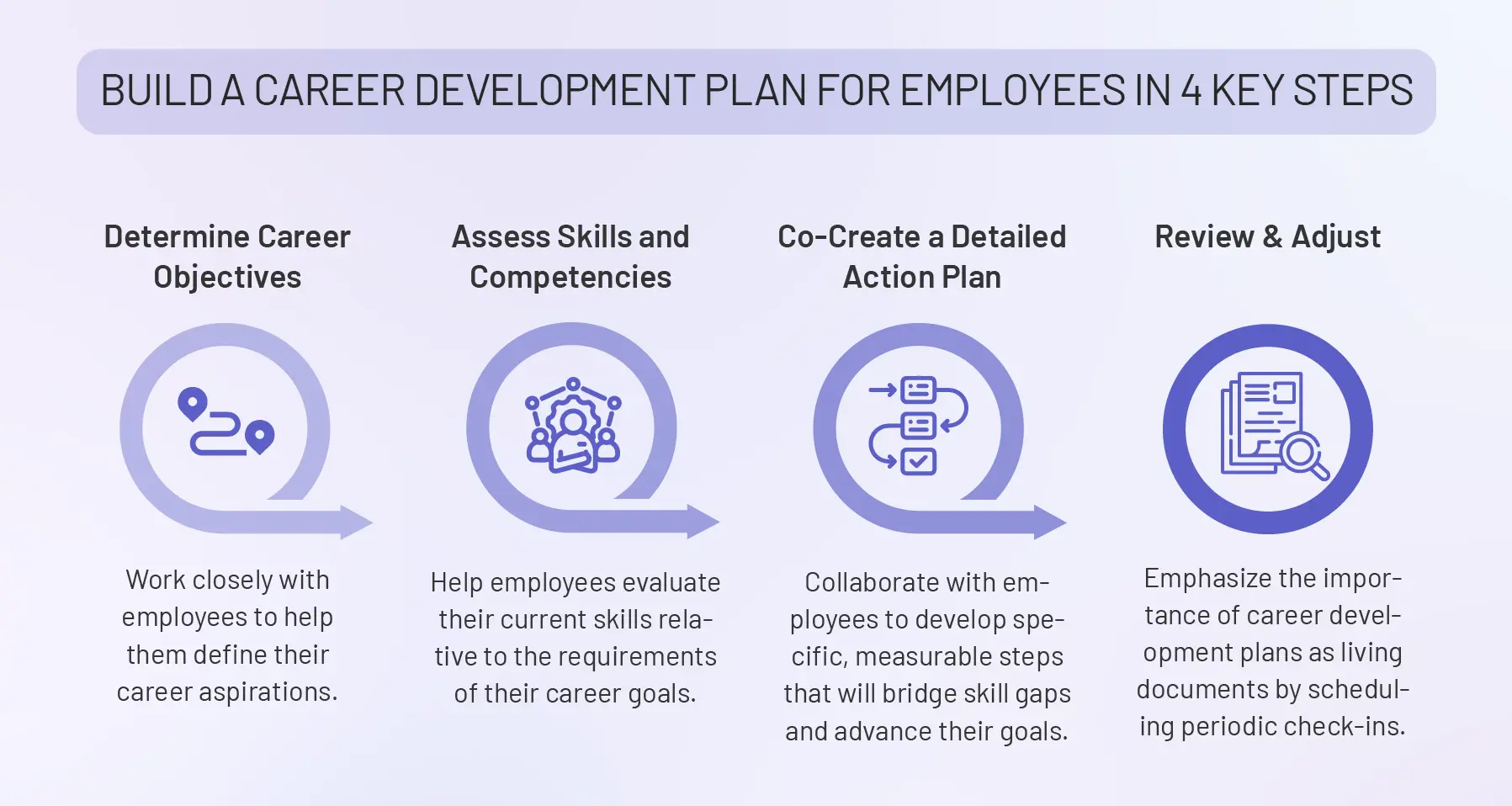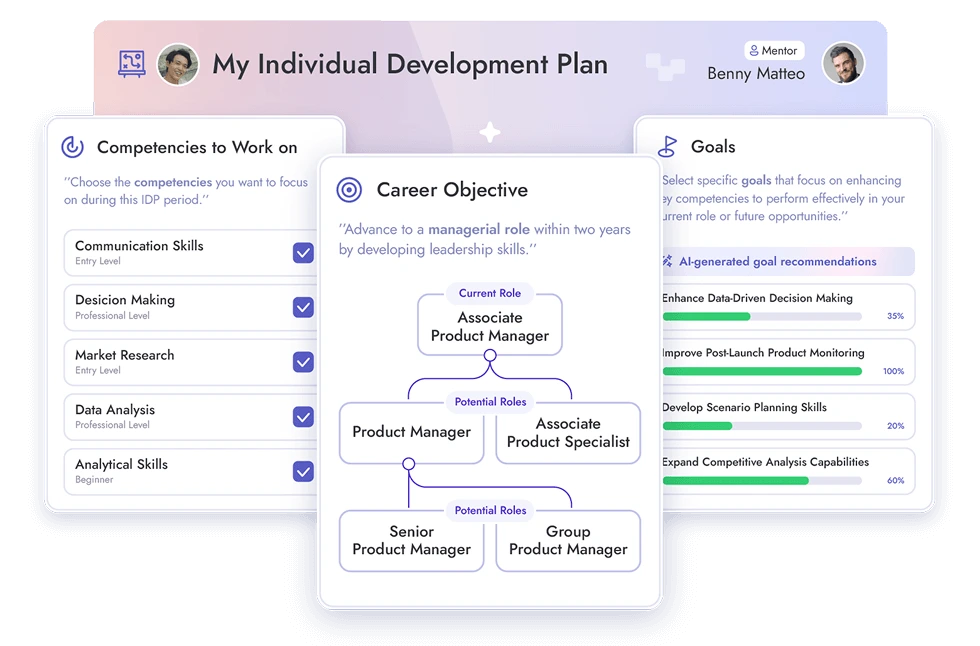Get the Ebook
.svg)
Organizations that prioritize career development as a core business strategy are significantly more confident in their ability to maintain talent and drive profitability. However, according to LinkedIn's 2025 Workplace Learning Report, only 36% of organizations currently qualify as “career development champions” with robust, strategic programs in place.
These champions outperform others in employee engagement, promotion rates, and leadership development, demonstrating the critical link between effective career development and organizational success.
Ultimately, a well-structured career development plan not only enhances employee engagement and cultivates future leaders but also plays a pivotal role in driving overall organizational success. This article explores the topic thoroughly to help businesses implement effective growth pathways for their workforce. Let’s dive into it.
A career development plan is a framework that guides individuals and HR professionals in outlining career goals, identifying the skills needed to reach them, and planning actionable steps to support growth. It’s an essential tool for organizing professional development and tracking progress over time.
This planning process is essential not only for professional growth but also for ongoing motivation and engagement. A well-designed career development plan enables continuous tracking of progress and facilitates timely adjustments, helping to overcome challenges and seize emerging opportunities.
It provides a clear, documented path that supports skills enhancement, career pathing, and succession planning. Career development plans, at the end of the day, contrinute greatly to job satisfaction, retention, and the development of a strong leadership pipeline.

By adopting a structured and supportive approach, HR can empower employees to clarify their aspirations, identify skill gaps, and chart clear development pathways that benefit both the individual and the organization. This step-by-step employee career development process ensures plans are realistic and most importantly, aligned with company goals
Work closely with employees to help them define their career aspirations using the SMART criteria (Specific, Measurable, Achievable, Relevant, Time-bound).
Encourage them to consider:
One thing human resources professionals need to guarantee in this step is make sure the being set not only align with an employees career goals or company objectives, but also their personal values.
Taking advantage of an individual development plan tool that also supports goals and OKRs and can assist greatly during this step to make sure career goals are visible, manageble, and tracked easily
Help employees evaluate their current skills relative to the requirements of their career goals by:
Competency assessments play an integral role in how HR departments can help their employees career development plans. Using an employee development tool like Teamflect that allows you to build branching career paths for every role in your organization with competencies associated with each role is can be a great asset here.
Determine where the employee is regarding the competencies they need to possess for the positions they are aspiring to and start setting development goals accordingly.
Collaborate with employees to develop specific, measurable steps that will bridge skill gaps and advance their goals, such as:
Proactively address potential obstacles, such as workload or scheduling conflicts, and develop strategies to overcome them.
Emphasize the importance of career development plans as living documents by scheduling periodic check-ins (e.g., quarterly or biannual):
This flexibility helps ensure the plan remains relevant and motivating over time.

Merely managing career development plans manually or through fragmented processes is no longer sufficient. HR professionals must adopt a comprehensive career pathing software to keep pace with employees’ growing expectations for personalized growth and with the business imperative to build agile, future-ready talent pipelines.
Using a career pathing / talent management software empowers organizations to:
Failing to integrate career pathing technology risks leaving HR teams overwhelmed, employees disengaged, and talent development efforts misaligned with strategic business needs.
Below, we will be showing you, step-by-step, how you can use Teamflect to collaborate on career development plans for employees.
With Teamflect, your employees can create their own professional development plans tailored specifically to their career goals, and the'r managers can collaborate with them seamlessly without ever leaving Microsoft Teams. Let's take a step-by-step look into how your employees can get started and how you can support their development journey!

Once your employees are inside Teamflect, they can click on their profile picture in the right-hand corner and access their personal information. When they scroll down, they'll see a feature titled "Ready To Grow?". By clicking on that button, they can begin creating their individual development plan.

The first step your employees take is selecting the main focus for their IDP. They'll determine if they're new to a role, currently developing in their position, or looking to move to an entirely different role. This clarity of purpose enables you, whether you are coming in from and HR or a managerial standpoint to better understand their aspirations and provide targeted support throughout their development journey.

Once your employees identify what they're looking to achieve with their individual development plan, they can set realistic timelines for their goals. Whether they're planning a short-term burst of growth, a medium-term development journey, or a long-term career transition, this timeline helps the company align resources and support accordingly.

Your employees can now detail their objectives with greater specificity. This section of their IDP provides:
All this information gives you valuable insight into where they are in their career journey and helps inform your coaching conversations.

In this section, your employees can specify their desired future role using your company's roles catalog and job leveling structure. They can browse through all available role types in your organization and identify positions that align with their interests

Your employees will select competencies that align with their career goals. Based on the information they've provided about their objectives, main goals, and future roles, Teamflect suggests relevant competencies that match their aspirations. They also have the flexibility to browse the entire competency catalog and make additional selections that resonate with their development needs.

As your employees near completion of their IDP, they'll establish key objectives to reach their aspirations. While they can add multiple goals in this section, the built-in AI feature can generate smart suggestions, making goal-setting efficient and comprehensive. This gives you concrete milestones to discuss and track during your regular check-ins.

Finally, your employees will identify the resources needed to achieve their goals and career aspirations. In this section of their individual development plan, they will:

Once they click create, their IDP is complete! The system will notify them of successful creation and suggest scheduling a one-on-one with their manager to begin tracking progress.
While they can skip this initially, IDPs require ongoing attention and regular one-on-ones provide the ideal framework for collaborative development and progress monitoring between you and your employees.
Creating a career development plan is essential for aligning employee growth with organizational success. These plans provide individuals with direction while helping companies retain talent and enhance productivity.
Key statistics highlighting this impact include:
Creating a career development plan is a powerful tool for growth, yet common pitfalls can undermine its effectiveness. Being aware of these mistakes helps HR professionals and employees design plans that truly foster progress and engagement.
Careers often involve obstacles that require thoughtful, proactive strategies to navigate effectively. The following table highlights five frequent challenges employees face along with practical approaches to support their growth and development.
A career development plan for employees is a powerful tool for effectively navigating your professional journey and achieving long-term success. By setting clear professional goals, thoroughly assessing existing skills, and creating detailed, actionable steps, individuals and HR professionals can drive meaningful progress and overcome common pitfalls that often hinder growth. Leveraging modern career development tools enhances this process by providing structure, tracking, and personalized guidance.
Whether aiming for individual advancement or fostering talent within an organization, a thoughtfully crafted career development plan remains essential for thriving in today’s fast-paced, dynamic job market.
An all-in-one performance management tool for Microsoft Teams
